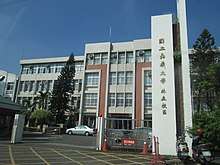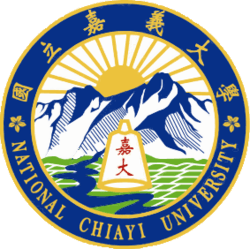National Chiayi University
National Chiayi University (NCYU; Chinese: 國立嘉義大學) is a public university located in Chiayi City and Chiayi County, Taiwan. It was formed in 2000 by merging National Chiayi Institute of Technology and National Chiayi Teachers College. The University has six colleges, which include seven doctoral programs, 42 full-time master's degree programs, twelve part-time master's degree programs, and 38 undergraduate programs now. NCYU is one of the oldest and largest universities in southern Taiwan.
國立嘉義大學 | |
 | |
Other name | NCYU |
|---|---|
Former names | Chiayi Agriculture and Forestry Public School Taiwan Provincial Chiayi Agri-Vocational School Taiwan Provincial Chiayi Junior College of Agriculture National Chiayi Institute of Technology Taiwan Provincial Chiayi Normal School Taiwan Provincial Chiayi Junior Teachers College Taiwan Provincial Chiayi Teachers College National Chiayi Teachers College |
| Motto | 誠樸、力行、創新、服務[1] |
Motto in English | Sincerity, Action, Innovation, Service[2] |
| Type | Public, national |
| Established | April 1919 (as Chiayi Agriculture and Forestry Public School) February 2000 (as National Chiayi University) |
| President | Chyung Ay |
| Vice-president | Liu Rong-yi (academic affairs) Huang Kuang-liang (administrative affairs) |
| Address | Chiayi City and Chiayi County in Taiwan 23°27′49.26″N 120°29′0.98″E |
| Campus | Urban |
| Website | www.ncyu.edu.tw |
 | |
| National Chiayi University | |||||||||
|---|---|---|---|---|---|---|---|---|---|
| Traditional Chinese | 國立嘉義大學 | ||||||||
| |||||||||

History
The history of the university can be traced back from the merger between two different schools.
The Chiayi Agriculture and Forestry Public School was established in April 1919 and reorganized and renamed as Taiwan Provincial Chiayi Agri-Vocational School in November 1945. The school was then upgraded to become Taiwan Provincial Chiayi Junior College of Agriculture in March 1965. In July 1981, it became a national college and funded by the Ministry of Education. In July 1997, it was upgraded again to become National Chiayi Institute of Technology.
The Taiwan Provincial Chiayi Normal School was founded in 1957. In August 1996, the school was upgraded to a five-year junior college and renamed Taiwan Provincial Chiayi Junior Teachers College. In July 1987, the college was reformed into a four-year college and renamed as Taiwan Provincial Chiayi Teachers College. In July 1987, the college was upgraded into a national college and renamed National Chiayi Teachers College.
In February 2000, National Chiayi Institute of Technology and National Chiayi Teachers College were merged and became National Chiayi University.[3]
Campuses
NCYU comprises four campuses:
Lantan Main Campus

The campus is the administrative headquarters and located in the well-known scenic area between Lantan Reservoir and Renyitan Reservoir. It also accommodates the College of Agriculture, College of Science and Engineering and College of Life Sciences.
- Address: 300 Syuefu Road, East District, Chiayi City
Minxiong Campus
This campus accommodates the Teachers College and College of Humanities and Arts.
- Address: 85 Wunlong Village, Minxiong Township, Chiayi County
Linsen Campus
Extension and lifelong learning programs are offered in the campus to provide educational service to the local community.
- Address: 151 Linsen East Road, East District, Chiayi City
Sinmin Campus
Sinmin Campus is situated in West District in downtown Chiayi. Sinmin accommodates College of Management and College of Veterinary medicine.
- Address: 580 Sinmin Road, West District, Chiayi City
Academics
NCYU consists of seven colleges (Agriculture, Humanities and Arts, Life Sciences, Management, Science and Engineering, Teachers, and Veterinary Medicine),[4] 36 departments and 11 independent institutes, with 500 full-time faculty professors.[5]
Notable alumni
- Chen Ming-wen, Magistrate of Chiayi County (2001-2009)
- Huang Min-hui, acting Chairperson of Kuomintang
Partner Institutions
Malaysia
See also
References
- "嘉大之教育目標、校訓與願景 (Chinese)". Nat'l Chiayi U. Retrieved August 25, 2014.
- "2011 National Chiayi University Commencement Remarks". Nat'l Chiayi U. Retrieved August 25, 2014.
- "Brief History". National Chiayi University. April 13, 2011. Retrieved December 26, 2017.
- "Departments & Colleges". ncyu.edu.tw. NCYU. Retrieved December 2, 2017.
- Brief History of Chiayi University in official site
External links
| Wikimedia Commons has media related to National Chiayi University. |
- Official website (in English)
- Official website (in Chinese)